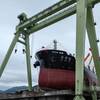As Britain's North Sea oil and gas stocks dwindle, the government is seeking new ways of harnessing natural resources to ensure a diverse and secure future energy supply. Now UPI reports, plans are afoot to utilize the North Sea's existing energy infrastructure to install a new generation of deepwater wind farms that could keep the lights on in a sustainable and environmentally benign manner. Talisman Energy U.K. Ltd. has teamed up with Scottish and Southern Energy to test the technological and economic feasibility of wind farms installed at an unprecedented water depth of 45 m. Work is under way to attach two of the world's largest wind turbines to the existing Beatrice oil platform 15 miles off the east coast of Scotland, an area that boasts some of the highest wind speeds on the planet.
A variety of factors, such as environmental concerns and space constraints, meant that shallow-water wind farms would eventually become unviable. When situated close to the shoreline, wind farms often conflict with other stakeholders, such as the shipping industry, nature reserves and local residents. But the farther out and the deeper they are, the fewer those kind of conflicts. Deepwater wind farms also have the potential to be far larger projects than their shallow-water counterparts while still maintaining minimum visibility. Airtricity, an Irish wind energy company, is planning a deepwater wind farm in the North Sea that would generate 10,000MW of electricity, enough to power more than eight million homes. The project is being developed to prove the concept of a European offshore supergrid, which would link wind farms from the Mediterranean to the Bay of Biscay, Atlantic, North Sea and Baltic Sea to provide a stable supply of green energy to European Union member states. And with increased generating capacity, offshore wind farms become more economically competitive, Airtricity notes. The minimal visual impact of deepwater installations has captured the imagination of environmental campaign groups on the other side of the Atlantic. The Alliance to Protect Nantucket Sound is keeping a keen eye on the Beatrice pilot project as a potential solution to siting issues involved with near-shore proposals like the Cape Wind project, proposed just over five miles from the shores of Cape Cod. Deepwater installations also have the potential to generate more energy than shallow-water wind farms. Being farther out to sea means fewer obstructions, and here, wind speeds are both higher and more consistent. While at present the increase in capacity does outweigh the costs involved with deepwater sites, this will change given some time. Talisman Energy U.K. eventually wants to install a 200 turbine farm at the Beatrice site, but according to industry analysts, it will take some time, but it will pay off.
Another key aspect of the Beatrice project is its utilization of technology and techniques developed in Britain's offshore oil and gas industry, highlighting the potential for workers to transfer their skills to jobs in the renewable energy sector as fossil fuel resources dry up. If successful, the project could generate investment opportunities for companies experienced in the oil and gas sector
The $65m Beatrice project is part of DOWNVInD (Distant Offshore Wind Farms With No Visual Impact In Deepwater,) the EU's largest renewable energy research and development program including 18 different organizations from six European countries. Its backers believe it will enable Europe to take a global lead in offshore wind farm technology. (Source: UPI)
Subscribe for
Maritime Reporter E-News
Maritime Reporter E-News is the maritime industry's largest circulation and most authoritative ENews Service, delivered to your Email five times per week










